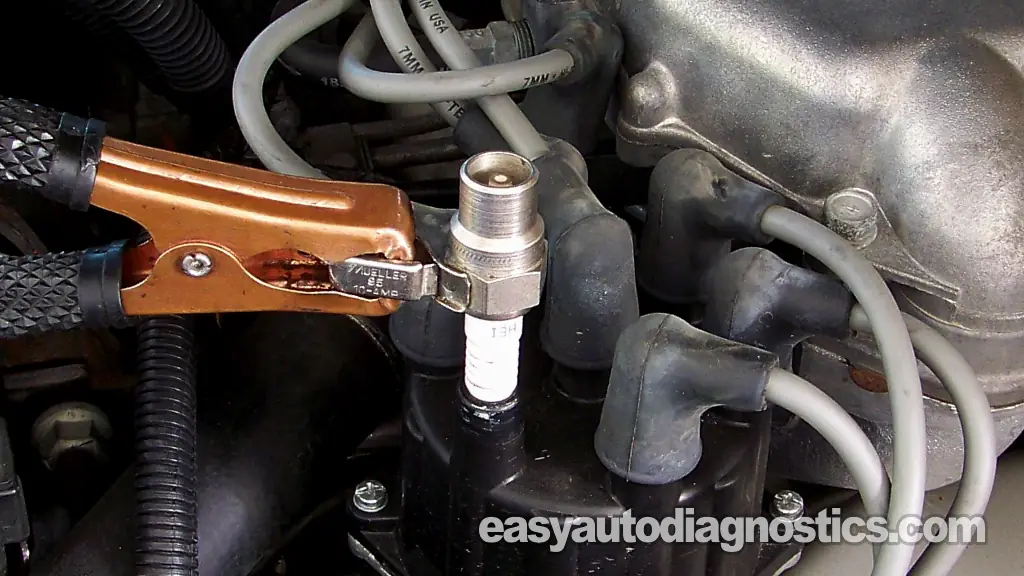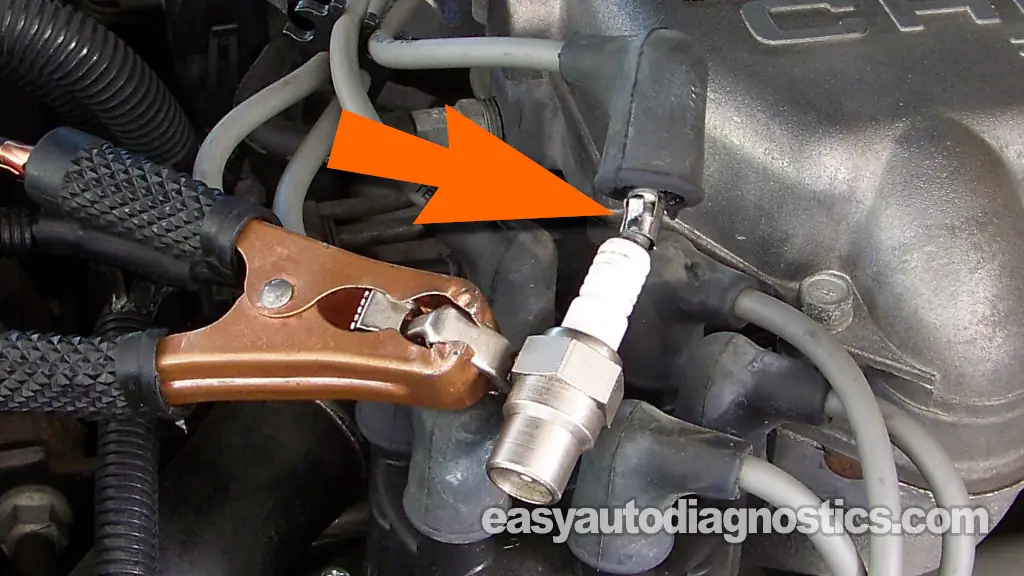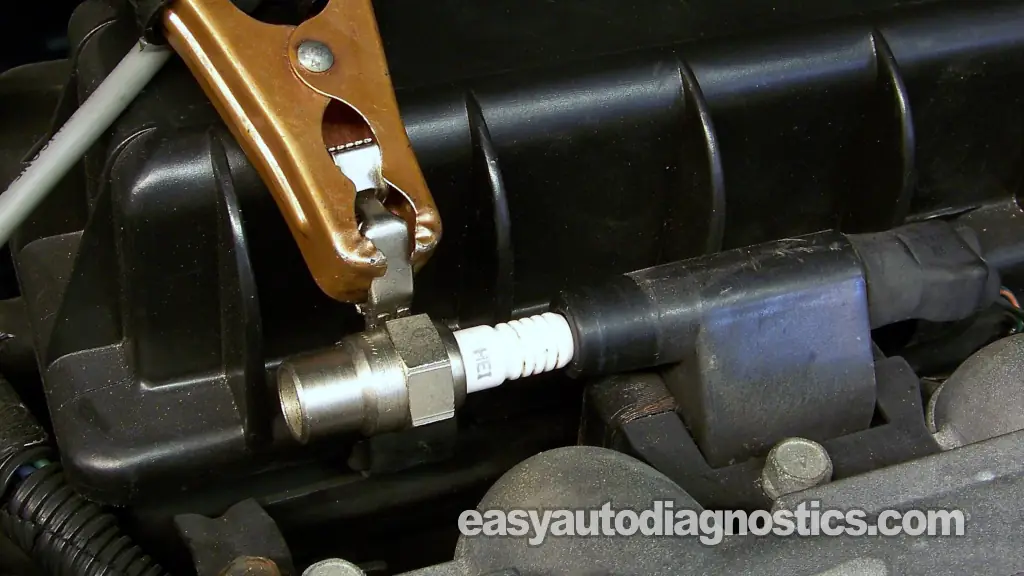TEST 2: Testing For Spark Directly On The Distributor Cap

So far, your tests result from TEST 1 confirm you've got one or more spark plug wires that are not sparking.
What we'll do in this test section is check for spark directly on the distributor cap tower or towers of those high tension wires that did not spark.
This test will help us determine, in an indirect way, if the high tension wire that did not spark is bad or if the distributor cap is bad.
NOTE: This test section is only for when one or several (but not all) of the spark plug wires did not spark in TEST 1.
IMPORTANT: To get the most accurate test result, use a spark tester to check for spark.
These are the test steps:
- 1
Remove the spark plug wire that did not spark from its tower on the distributor cap.
- 2
Place the spark tester directly on the tower (see photo above).
- 3
Connect the spark tester to the battery negative (-) post with a battery jump start cable.
You can also connect the spark tester to a clean and unpainted metal surface on the engine.. - 4
Have your assistant crank the engine while you observe the spark tester.
- 5
The spark tester should spark as the engine is cranking.
- 6
Reconnect the spark plug wire to the dist. cap tower you just finished testing.
- 7
Repeat this test on the other towers whose high tension wire did not fire off spark in TEST 1 (if applicable).
Let's find out what your test results mean:
CASE 1: You got spark from the distributor cap tower. This is the correct test result.
You can conclude that the spark plug wire is bad, replace them all. This is probably as far as you may need to go since your car or mini-van will probably start and run without a misfire problem after replacing these parts.
Here's why: As the spark plug wire ages, its normal resistance to spark increases to the point that the wire can not and does not transmit the spark to the spark plug. This will either cause a misfire, or a lack of power, or a no-start condition. Spark plug wires don't last forever, especially after-market ones (average life-span is 3 to 4 years).
CASE 2: You got NO spark from the distributor cap tower. With this test result you can conclude that the distributor cap is bad.
Replace the distributor cap and distributor rotor as a set. This should solve your misfire problem. If the spark plug wires and spark plugs are as old as the distributor cap and rotor, I would recommend that you replace them all.
Here's why: As the distributor cap ages, the terminals that transmit the spark to the spark plug wires corrode. This corrosion increases the resistance to spark and over time (as more corrosion is created) this same corrosion stops the spark from passing thru' to the spark plug wires.
TEST 3: Ignition Coil High Tension Wire Spark Test

You've reached this test step because you have verified that none of the spark plug wires are firing spark (in TEST 1).
For our next step, we're gonna check that the ignition coil's high tension wire is actually delivering spark to the distributor cap.
To accomplish this, we'll simply connect the spark tester to the ignition coil's high tension wire, crank the engine, and see if the spark tester sparks.
This test will let us know if the spark plug wire (high tension wire) that feeds spark from the ignition coil do the distributor is bad or if we need to move on to TEST 4.
Let's get started:
- 1
Disconnect the ignition coil's high tension wire from the center of the distributor cap.
IMPORTANT: Leave the other end of the high tension wire connected to the ignition coil. - 2
Attach the HEI spark tester to the wire (see photo above).
IMPORTANT: Make sure that the metal terminal that fits into the distributor cap tower (and that is now exposed) does not come in close proximity to any metal part of the engine or the spark will arch to Ground instead of jumping across the spark tester's air gap. - 3
Connect the HEI spark tester to the battery negative (-) post with a battery jump start cable.
- 4
Ask your helper to crank the engine while you observe the spark tester.
- 5
The spark tester should spark the entire time the engine is cranking..
Let's analyze your test result:
CASE 1: You got spark. This is the correct test result.
This result confirms that spark is being delivered to the distributor but that the distributor cap is unable to distribute the spark to the spark plug wires.
Also, this test confirms that the ignition coil is GOOD. Replace the distributor cap and rotor as a set and retest (or crank up the vehicle). This should solve your no-start condition.
CASE 2: You got NO spark. Then further testing is required to see if the problem is due to a bad ignition coil, bad crankshaft position sensor, or something else.
Your next step is to go to: TEST 4: Testing For Spark Directly On The Ignition Coil's Tower.
TEST 4: Testing For Spark Directly On The Ignition Coil's Tower

So far, your previous tests have:
- Confirmed that none of the spark plug wires are sparking (TEST 1).
- Confirmed the ignition coil's high tension wire is not sparking (TEST 3).
Now we need to check for spark directly on the ignition coil's tower. If the ignition coil tower makes the spark tester spark, we can conclude that the ignition coil high tension wire (we just tested in TEST 3) is bad.
If the spark tester does not spark, then off we go to TEST 5 and check that the ignition coil is getting power.
OK, let's get going:
- 1
Remove the high tension wire from the ignition coil's tower.
- 2
Place the spark tester in the ignition coil's tower (see the photo above).
- 3
Connect the spark tester to the battery negative (-) terminal with a battery jump start cable.
NOTE: The battery jump start cable will also aid you in holding the spark tester in place on the distributor cap. - 4
When ready, ask your helper to crank the engine as you observe the spark tester.
- 5
The spark tester should spark the whole time the engine is cranking.
Let's analyze your test result below:
CASE 1: You got spark. This is the correct test result.
You can conclude that the spark plug wire that connects to the distributor cap spark is bad and the ignition coil is GOOD if you have:
- Confirmed that none of the spark plug wires are sparking (TEST 1).
- Confirmed that the ignition coil's high tension wire is not sparking (TEST 2).
Replace the ignition coil high tension wire by replacing all of the spark plug wires to solve the engine no-start problem.
Here's why: As the spark plug wire ages, its normal resistance to spark increases to the point that the wire can not and does not transmit the spark to the spark plug. This will either cause a misfire, or a lack of power, or a no-start condition. Spark plug wires don't last forever, especially after-market ones (average life-span is 3 to 4 years).
CASE 2: You got NO spark. The next step is to verify that the ignition coil is getting power (10 to 12 Volts), go to: TEST 5: Making Sure The Ignition Coil Is Getting 12 Volts.
